I first discovered Pancit Langlang during a rainy afternoon at my Tita Rose's house in Batangas. While other kids were glued to their phones, I found myself drawn to her tiny kitchen, watching her methodically prepare this special noodle dish. She explained how every family has their own version, but this one was passed down from her mother – my grandmother – who learned it from her own mother in the 1950s.
What makes our family's version special is the extra step of poaching the chicken to create a rich broth, a technique my Tita insists makes all the difference. I'm excited to share our family's take on this beloved dish that even Jose Rizal couldn't resist.
Jump to:

Why You'll Love This Recipe
- Historical Significance: Enjoyed by national hero Jose Rizal during his time in Europe
- Dual Texture Experience: Combines two types of noodles for interesting texture contrast
- Versatile: Can be customized with different proteins and vegetables
- Complete Meal: Packed with protein, vegetables, and carbohydrates
- Perfect for Gatherings: Easily scalable for parties and celebrations
- Budget-Friendly: Uses accessible ingredients
- Time-Efficient: Most prep can be done while chicken is poaching
Ingredients
The ingredients in this Pancit Langlang recipe create a perfect harmony of flavors and textures. The combination of fresh miki and sotanghon noodles provides contrasting textures - one chewy, one silky.
Chicken and pork deliver rich protein, while the vegetables add color, nutrients, and crunch. The aromatic blend of garlic, onions, and sesame oil creates depth, while oyster sauce provides that essential umami foundation.
Each component plays a crucial role in this balanced dish, using everyday ingredients that transform into something extraordinary through proper technique.
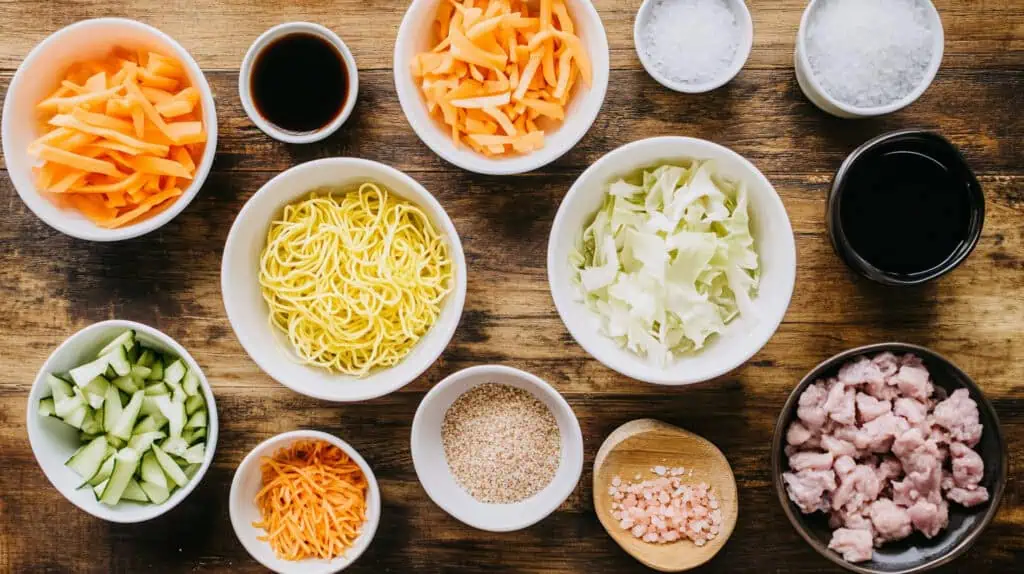
- For Poaching Chicken:
- 1 pound boneless skinless chicken breasts
- 1 onion, quartered
- 1 teaspoon salt
- 1 teaspoon peppercorns
- 2 bay leaves
- Water for poaching (enough to cover chicken by 1 inch)
- For the Noodle Dish:
- 4 ounces cellophane noodles/sotanghon, soaked in warm water
- 16 ounces fresh miki noodles, thin and flat
- 2 tablespoons vegetable oil
- 1 onion, chopped
- 3 cloves garlic, minced
- 1 pound ground pork
- ¼ cup oyster sauce
- 2 tablespoons sesame oil
- 1 cup julienned carrots
- 1 cup thinly sliced green beans
- ½ small cabbage, sliced thinly
- 2 cups reserved chicken broth
Equipment
- Large Pot: For poaching chicken and creating the flavorful broth base that will infuse the entire dish with rich flavor
- Wok or Large Skillet: With high sides to prevent ingredients from spilling during the stir-frying process
- Tongs: Essential for gently handling and tossing the noodles without breaking them
- Sharp Knife: For precise, uniform cutting of vegetables which ensures even cooking
- Cutting Board: Provides a stable surface for all your prep work
- Colander: For properly draining the soaked noodles before adding them to the dish
- Measuring Cups and Spoons: For accurate ingredient measurements that maintain consistency
- Bowl: For soaking the cellophane noodles until they soften properly
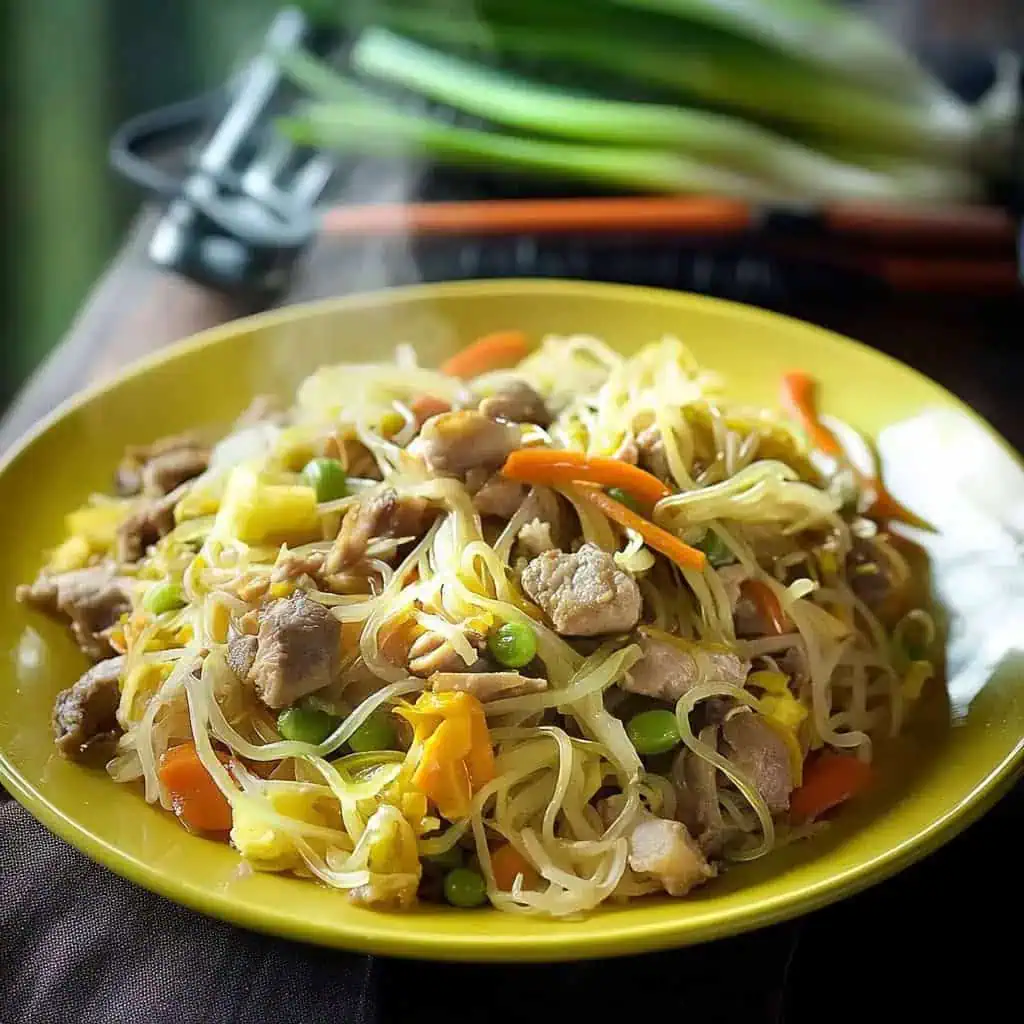
How To Make
- Prepare the Chicken and Broth: Place chicken breasts in a large pot with quartered onions, salt, peppercorns, and bay leaves. Add cold water until it covers the chicken by one inch. Bring to a boil, then reduce heat to low and simmer covered for 10-15 minutes until chicken is cooked through. Remove chicken, let it cool, then shred it into pieces. Strain the liquid and save 2 cups of this flavorful broth.
- Prepare the Noodles: While the chicken cooks, soak your cellophane noodles in warm water until they soften completely. Once soft, drain and set aside. This is also an ideal time to prepare your vegetables.
- Start the Stir-Fry Base: Heat vegetable oil in a large wok or wide pan over medium heat. Add chopped onions and minced garlic, cooking until the onions become translucent and aromatic. Add ground pork and cook until it turns light brown, breaking up any lumps as it cooks.
- Add Vegetables: Add your carrots and green beans to the pan. Cook for one minute. Add the sliced cabbage and cook for another minute. The vegetables should remain crisp at this stage.
- Combine All Elements: Pour in the oyster sauce and sesame oil, stirring everything together. Now add both the softened cellophane noodles and fresh miki noodles to the pan. Pour in one cup of your reserved chicken broth, add the shredded chicken, and gently toss everything together using tongs.
- Finish Cooking: Add more broth as needed if the noodles look dry. Keep gently tossing until the noodles are cooked but still firm and most of the liquid has been absorbed. The vegetables should be tender-crisp. Taste and add salt and pepper if needed.
- Serve: Present hot, garnished with toasted garlic and green onions if desired. Place calamansi halves on the side for guests to squeeze over individual portions.

Tips from Lola's Kitchen
- Time Management: Utilize the chicken poaching time to prepare vegetables and soak noodles
- Flavor Boost: Add a chicken bouillon cube to the poaching liquid for more intense flavor
- Vegetable Texture: Don't overcook the vegetables—they should maintain a pleasant crisp-tender bite
- Noodle Perfection: Test noodle doneness by tasting—they should be firm but not hard
- Moisture Control: Add liquid gradually to prevent a soupy consistency
- Gentle Handling: Toss ingredients carefully to maintain noodle integrity and prevent breaking
- Aromatic Finish: Freshly toasted garlic adds tremendous flavor—make extra to sprinkle on top
Traditional Serving Suggestions
- Serve hot on a large serving platter
- Garnish with toasted garlic, chopped green onions, and calamansi halves
- Optional: Sprinkle with crushed chicharon for added texture and flavor
- Perfect pairings include puto (steamed rice cakes), pandesal (Filipino bread rolls), or steamed rice
Substitutions
- Chicken: Substitute with pork strips, shrimp, or firm tofu
- Ground Pork: Use ground chicken, turkey, or textured vegetable protein
- Fresh Miki: Egg noodles or any wheat-based flat noodles work well
- Sotanghon: Bean thread noodles or bihon rice noodles are suitable alternatives
- Oyster Sauce: Mix soy sauce with a pinch of sugar and a drop of molasses
- Sesame Oil: Any neutral cooking oil will work, though you'll lose the distinctive nutty aroma
- Green Beans: Snow peas, snap peas, or long beans are excellent substitutes
Troubleshooting
- Noodles Too Soft: Reduce cooking time and liquid amount in your next attempt. For current batch, add a splash of vinegar to help firm them slightly
- Dish Too Dry: Add chicken broth gradually, ¼ cup at a time, until desired consistency is reached
- Vegetables Too Soft: Add them later in the cooking process next time. For now, quickly stir in some fresh bean sprouts for added texture
- Noodles Breaking: Use tongs instead of a spatula and handle more gently. Make sure noodles are properly soaked but not over-soaked
- Bland Taste: Enhance flavor with a splash of fish sauce or additional oyster sauce
Storage & Reheating
- Refrigeration: Store in an airtight container for up to 3 days
- Not Freezer-Friendly: The texture of noodles significantly deteriorates when frozen
- Microwave Reheating: 2-3 minutes on medium power, stirring halfway through
- Stovetop Reheating: Warm on low heat with a splash of water or broth to rejuvenate
- Quality Note: The dish is best enjoyed fresh as noodles tend to absorb liquid and soften over time
- Single Reheat: Avoid reheating multiple times to maintain food safety
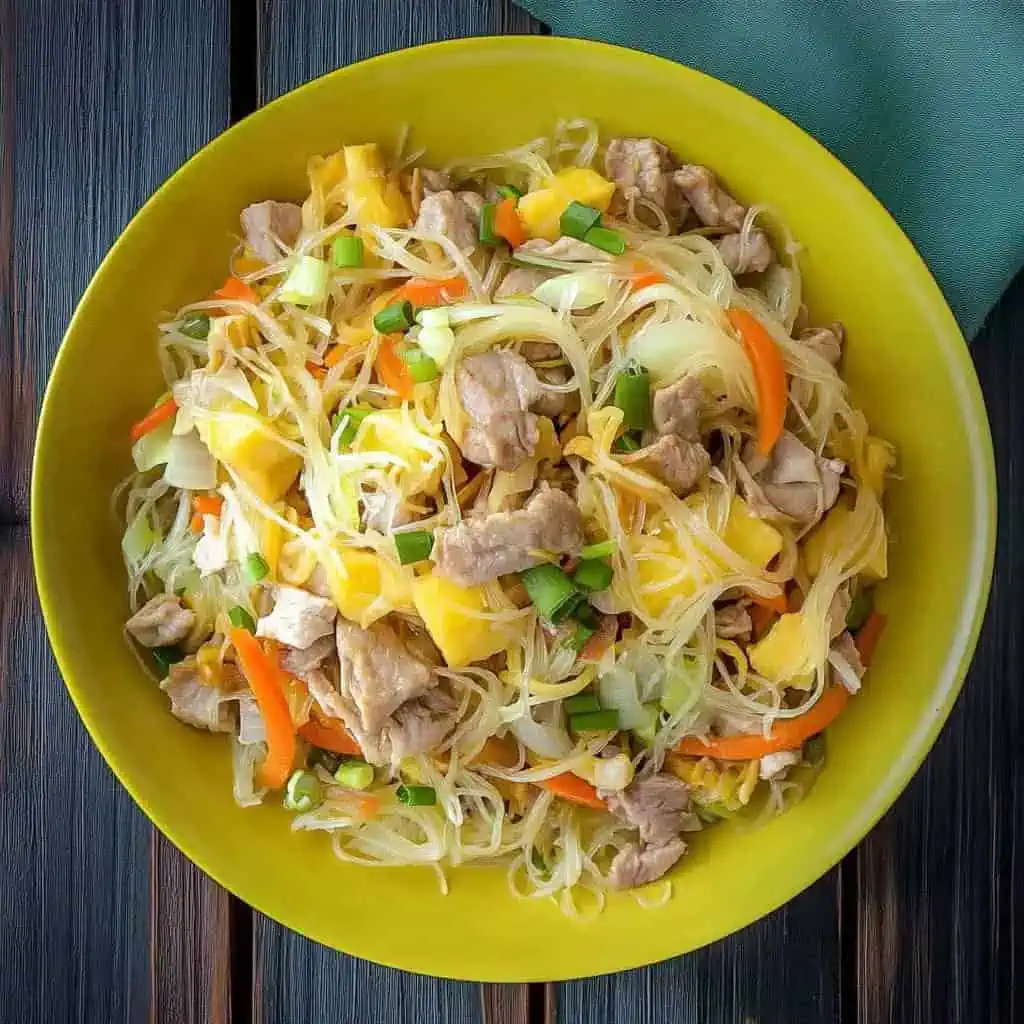
FAQ
Why combine two types of noodles?
The dual-noodle approach creates an interesting texture contrast in every bite. Each noodle type absorbs flavors differently, adding complexity to the dish. This combination is also traditional, honoring the historical roots of the recipe.
Can I make this ahead of time?
While Pancit Langlang is best served fresh, you can prepare all ingredients the day before. Store components separately in the refrigerator and combine them during the final cooking process for optimal texture and flavor.
Is this dish spicy?
The traditional version is not spicy. However, you can easily add chili flakes, sliced fresh chilies, or hot sauce to taste if you prefer some heat.
Why was this Jose Rizal's favorite?
Pancit Langlang combined local Filipino and Chinese culinary influences that were significant during Rizal's time. Its comfort food qualities likely reminded him of home during his European stays, providing both nourishment and nostalgia.
Can I make a vegetarian version?
Absolutely! Replace the meat with firm tofu, mushrooms (shiitake works particularly well), or plant-based ground meat substitutes. Use vegetable broth instead of chicken broth, and verify that your oyster sauce is vegetarian (mushroom-based versions are available).
What makes the broth so important?
The homemade chicken broth creates a foundation of flavor that store-bought versions can't match. The slow poaching method extracts deep flavor from the chicken while keeping the meat tender. This broth then infuses the noodles, creating a harmonious taste throughout the dish.
How do I prevent the noodles from sticking together?
Properly soaking the cellophane noodles until they're just soft (not mushy) and adding the right amount of liquid to the wok are key. Also, use tongs to gently separate and toss the noodles continuously during cooking.
Can I add other vegetables?
Absolutely! Bell peppers, snow peas, baby corn, and mushrooms all work wonderfully in this versatile dish. Just be mindful of different cooking times—add firmer vegetables earlier and quick-cooking ones toward the end.
Related
Looking for other recipes like this? Try these:
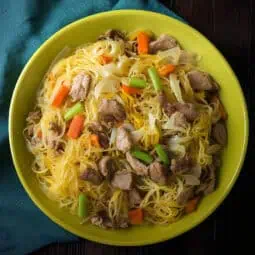
Pancit Langlang Recipe
Equipment
- Large pot (kaldero) for poaching chicken and creating flavorful broth
- Wok or large skillet (kawali) for stir-frying with high sides to prevent spillage
- Tongs [Sipit] for gentle handling of noodles
- Sharp knife (kutsilyo) for uniform cutting of vegetables
- Cutting board (Sangkalan) for prep work
- Colander (salaan) for draining noodles
- Measuring cups and spoons (Panukat) for precise measurements
- Bowl (mangkok) for soaking noodles
Ingredients
For Poaching Chicken
- 1 pound boneless skinless chicken breasts (dibdib ng manok)
- 1 onion quartered (sibuyas)
- 1 teaspoon salt asin
- 1 teaspoon peppercorns paminta
- 2 bay leaves dahon ng laurel
- Water for poaching
For the Noodle Dish
- 4 ounces cellophane noodles/sotanghon soaked in warm water
- 16 ounces fresh miki noodles thin and flat
- 2 tablespoons vegetable oil mantika
- 1 onion chopped (sibuyas)
- 3 cloves garlic minced (bawang)
- 1 pound ground pork giniling na baboy
- ¼ cup oyster sauce
- 2 tablespoons sesame oil
- 1 cup julienned carrots karot
- 1 cup thinly sliced green beans sitaw
- ½ small cabbage sliced thinly (repolyo)
- 2 cups reserved chicken broth
Instructions
- Begin by placing chicken breasts in a large pot with quartered onions, salt, peppercorns, and bay leaves. Add cold water until it covers the chicken by one inch. Bring to a boil, then reduce heat to low and simmer covered for 10-15 minutes until chicken is cooked through. Remove chicken, let it cool, then shred it into pieces. Strain the liquid and save 2 cups of this broth.
- While the chicken cooks, soak your cellophane noodles in warm water until they soften. Once soft, drain and set aside. This is also a good time to prepare your vegetables.
- Heat vegetable oil in a large wok or wide pan over medium heat. Add chopped onions and minced garlic, cooking until the onions become clear and soft. Add ground pork and cook until it turns light brown, breaking up any lumps as it cooks.
- Add your carrots and green beans to the pan. Cook for one minute. Add the sliced cabbage and cook for another minute. The vegetables should still be crisp at this point.
- Pour in the oyster sauce and sesame oil, stirring everything together. Now add both the softened cellophane noodles and fresh miki noodles to the pan. Pour in one cup of your reserved chicken broth, add the shredded chicken, and gently toss everything together using tongs.
- Add more broth as needed if the noodles look dry. Keep gently tossing until the noodles are cooked but still firm and most of the liquid has been absorbed. The vegetables should be tender-crisp. Taste and add salt and pepper if needed.
- Serve hot, garnished with toasted garlic and green onions if you like. Place calamansi halves on the side for squeezing over individual portions.
Tips from Lola's Kitchen
- Save time by preparing vegetables while chicken is poaching
- For extra flavor, add chicken bouillon cube to poaching liquid
- Don't overcook the vegetables - they should remain crisp-tender
- Test noodle doneness by tasting - should be firm but not hard
- Add liquid gradually to prevent soupy texture
- Keep tossing gentle to maintain noodle integrity
Nutrition
The Story Behind Pancit Langlang
Long before Pancit Langlang graced modern Filipino tables, it earned a special place in Philippine history as Jose Rizal's favorite comfort food. During his exile in Europe in the late 1800s, our national hero would often write to his brother Paciano, specifically requesting these noodles be sent to him – a testament to the dish's irresistible appeal that transcended borders and time.
What makes this historical connection even more fascinating is Rizal's mention of Pancit Langlang in his seminal novel, El Filibusterismo. In Chapter XXV, titled "Tawanan-Iyakan," he describes it not just as a noodle dish but as "sopas na pinakamabuti" (the best soup). This literary reference offers us a glimpse into how this beloved dish was enjoyed during the Spanish colonial period, when it was served as a soup rather than the stir-fried version we know today.
The evolution of Pancit Langlang reflects the beautiful diversity of Filipino cuisine. Each region has embraced and adapted the dish to its local tastes and ingredients. In Iloilo, you'll find a soup version that incorporates pancit molo wrappers, while Cavite's interpretation leans closer to pancit mami. Perhaps most similar to the modern version is Batangas' take, which combines fresh miki noodles with either bihon or sotanghon in a satisfying stir-fry.
Originally, "langlang" referred not to the dish itself but to a specific type of noodle – a flat, thin miki similar to what we use today. Over time, the name came to represent the entire dish, showcasing how Filipino food traditions evolve while maintaining their historical roots. The combination of two types of noodles in modern versions speaks to our culture's knack for fusion, bringing together different textures and flavors in one harmonious dish.
What's particularly remarkable about Pancit Langlang is its staying power. While many colonial-era dishes have faded into obscurity, this noodle dish has remained relevant, adapting to changing tastes while maintaining its essential character. Today's version, with its mixture of fresh miki and sotanghon, tender meats, and crisp vegetables, offers a perfect balance of textures and flavors that continues to captivate Filipino food lovers, just as it did over a century ago.
This dish embodies not just Filipino culinary ingenuity but also our deep connection to food as a bridge between past and present. Each bowl of Pancit Langlang serves as a delicious reminder of our rich culinary heritage, making it more than just a meal – it's a taste of Philippine history.
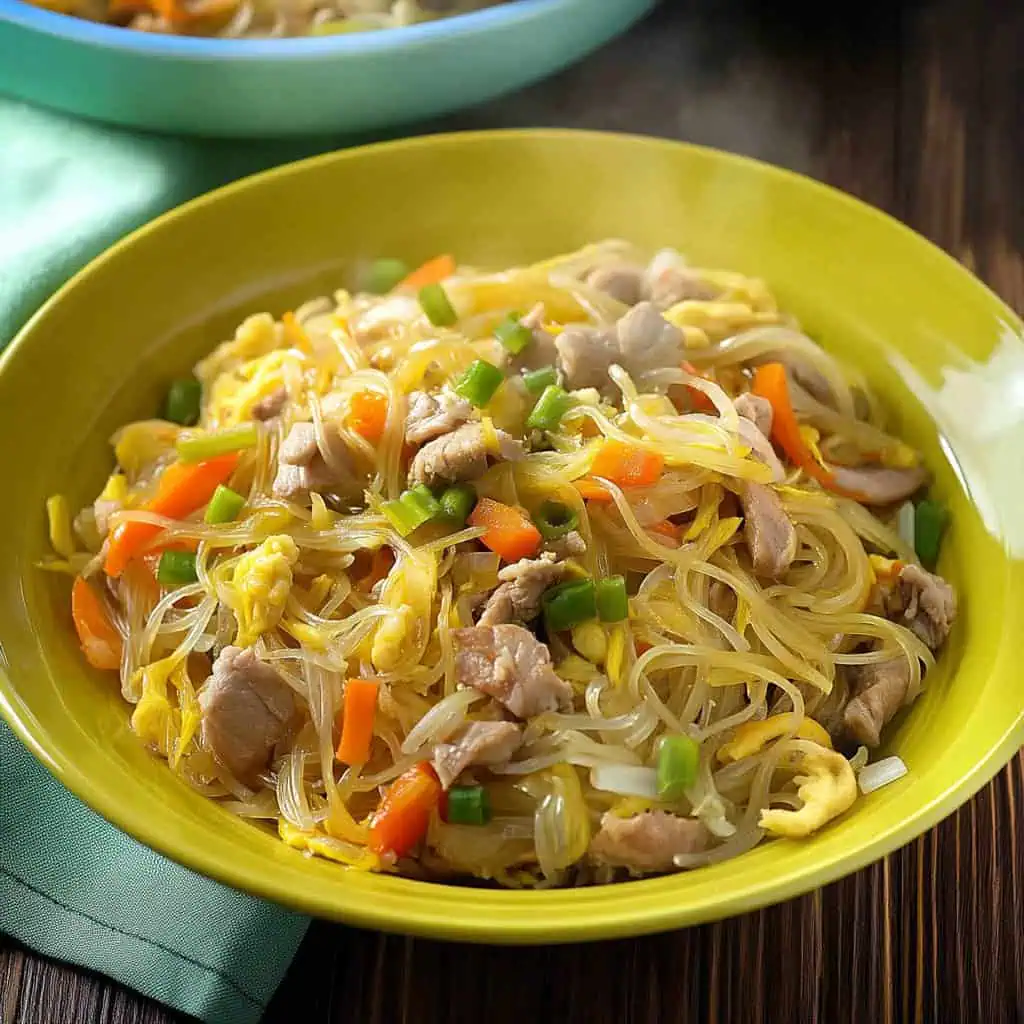





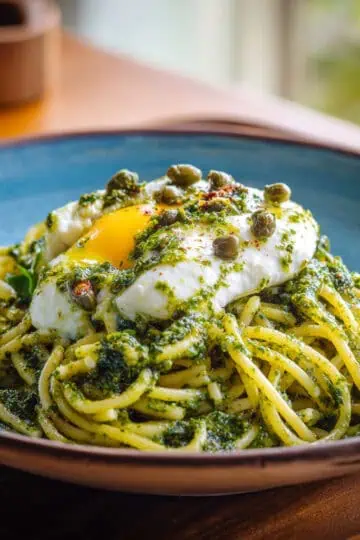
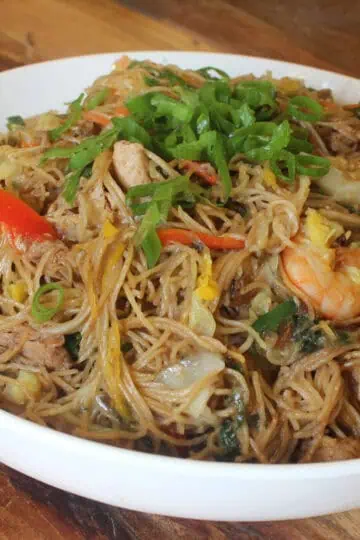
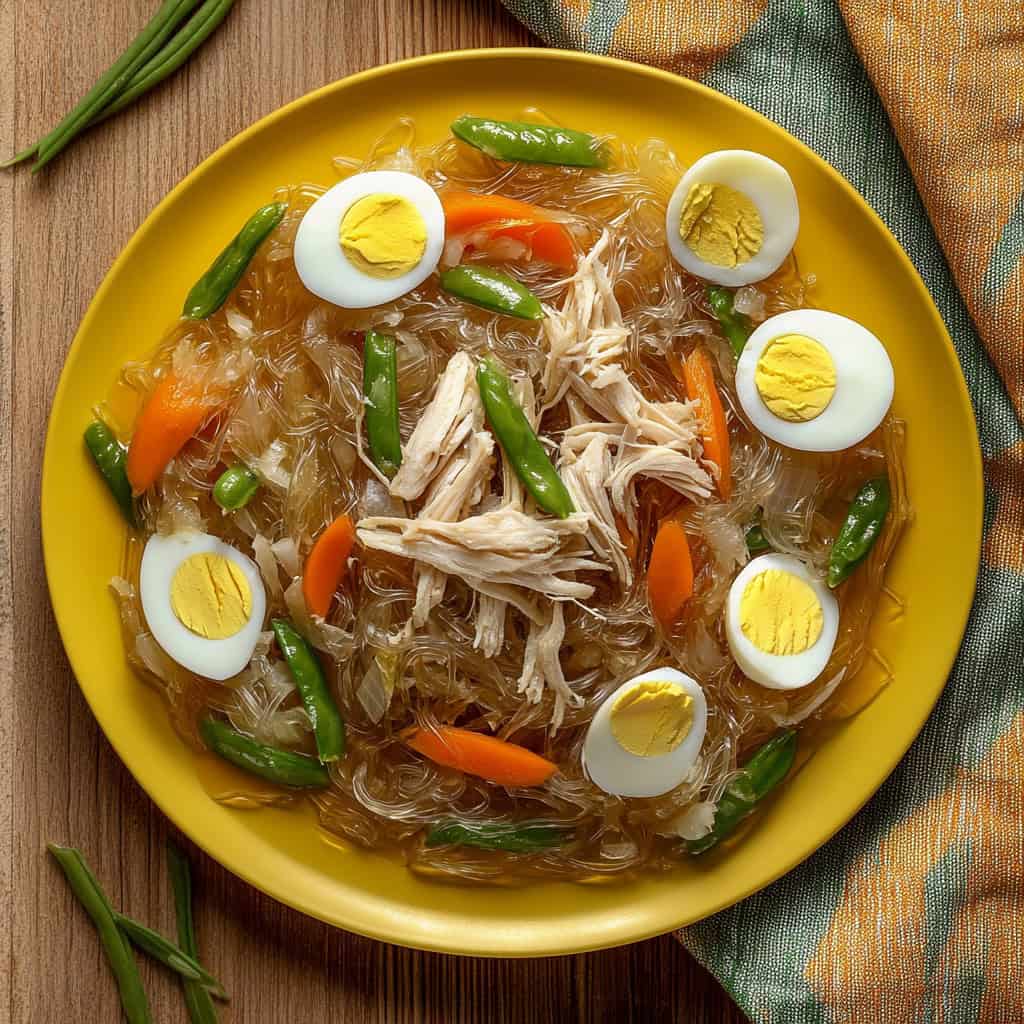
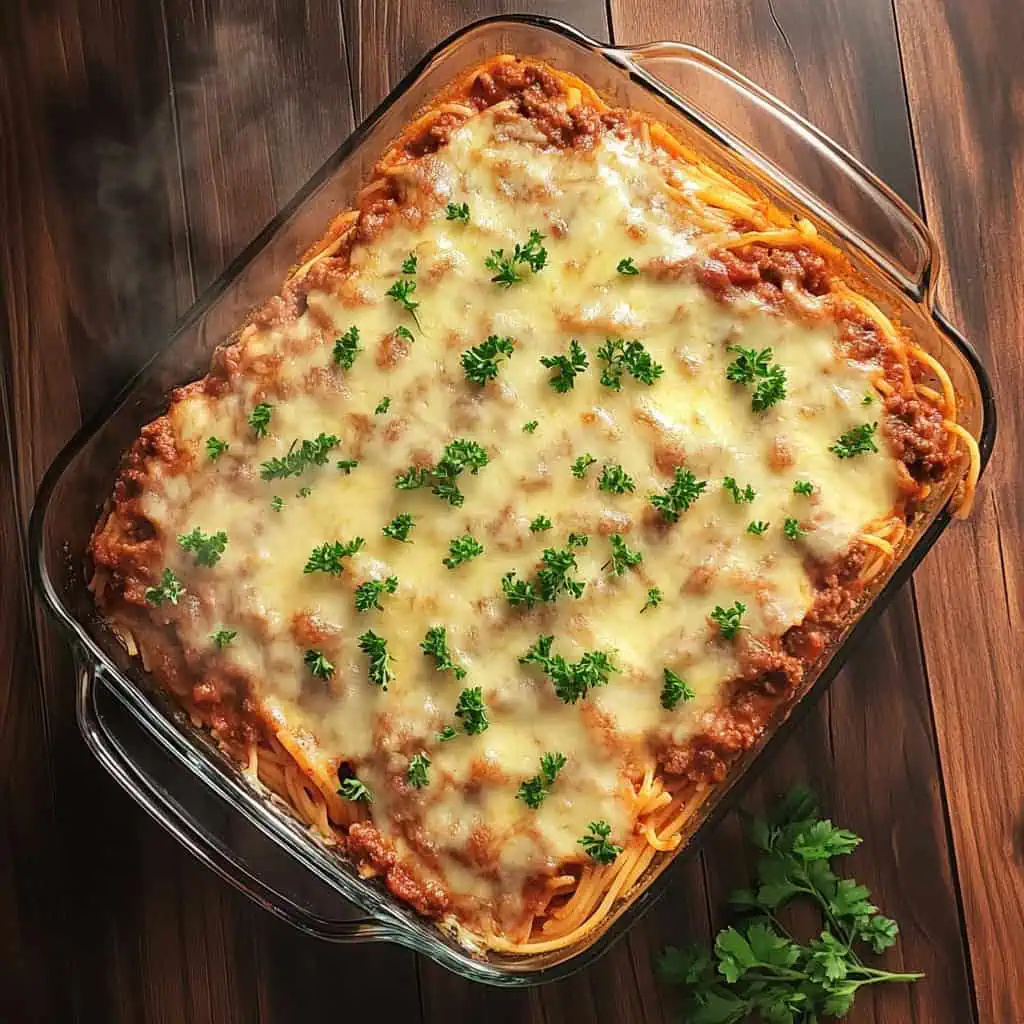
Comments
No Comments